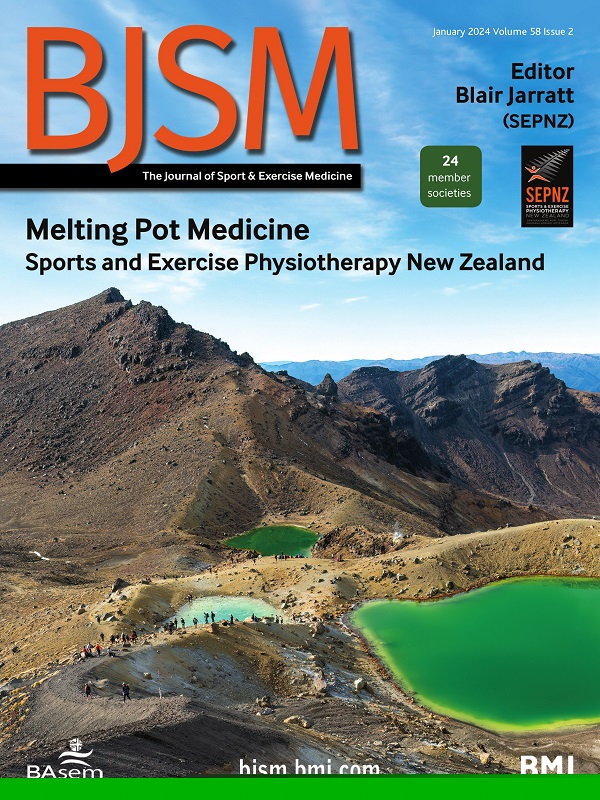Sport-specific concomitant injuries, return-to-sport rates and second anterior cruciate ligament (ACL) injuries in adolescents with ACL reconstruction.
IF 11.6
1区 医学
Q1 SPORT SCIENCES
引用次数: 0
Abstract
OBJECTIVE To evaluate differences in sport-specific concomitant injuries, return-to-sport (RTS), second ACL injuries and Knee Injury and Osteoarthritis Outcome Score (KOOS) subscales after adolescent ACL reconstruction (ACLR) across popular sports. METHODS This prospective cohort study included patients aged 10-18 years at ACLR. Demographic and injury-related data and KOOS subscales before ACLR and at the 1 and 2 years follow-ups were obtained. A survey to assess sport-specific outcomes and RTS was sent to eligible patients. Group comparisons were performed between the most popular sports and between females and males. RESULTS Overall, 1392 patients with a mean age of 16.4±1.4 years at ACLR were included. The mean time between ACLR and survey completion was 9.7±4.2 years. The most prevalent type of sport was soccer, followed by handball, floor hockey/field hockey, basketball and other sports. Concomitant injuries (71%) and second ACL injuries (30%; 20% ipsilateral, 13% contralateral) were common across all sports. No significant differences were found in ipsilateral second ACL injuries across sexes and sports. 24% of patients competed at an elite level sport (highest national level of junior sport or higher) for some period after ACLR. 8% of patients did not RTS at all, with females significantly more often without RTS than males (9% vs 4%, p=0.041). Significant improvements were observed in KOOS subscales from baseline to the 1 and 2 years follow-ups for all sports. CONCLUSION Concomitant injuries are frequently observed after ACL injury in adolescents, with nearly one-third suffering a second ACL injury. While significant improvements in KOOS subscales and return to high-level sports can be expected, better injury prevention is needed after ACLR.运动特异性伴随损伤,恢复运动率和第二前交叉韧带(ACL)损伤的青少年ACL重建。
目的评估青少年ACL重建(ACLR)后运动特异性伴随损伤、重返运动(RTS)、第二ACL损伤和膝关节损伤和骨关节炎结局评分(oos)亚量表在流行运动中的差异。方法本前瞻性队列研究纳入ACLR 10-18岁患者。获得ACLR前、随访1年和2年的人口学和损伤相关数据以及oos量表。一项评估运动特异性结果和RTS的调查被发送给符合条件的患者。在最受欢迎的运动之间以及在女性和男性之间进行了组比较。结果共纳入1392例ACLR患者,平均年龄为16.4±1.4岁。从ACLR到调查完成的平均时间为9.7±4.2年。最流行的运动是足球,其次是手球、地板曲棍球、篮球和其他运动。伴发损伤(71%)和二次前交叉韧带损伤(30%);20%同侧,13%对侧)在所有运动中都很常见。同侧第二前交叉韧带损伤在性别和运动方面没有显著差异。24%的患者在ACLR后的一段时间内参加了精英水平的运动(国家最高水平的青少年运动或更高水平)。8%的患者完全没有RTS,女性患者明显多于男性患者(9% vs 4%, p=0.041)。从基线到所有运动的1年和2年随访,在kos亚量表中观察到显著改善。结论青少年前交叉韧带损伤后多发并发损伤,近三分之一的青少年发生第二次前交叉韧带损伤。虽然可以预期kos亚量表的显著改善和高水平运动的恢复,但ACLR后需要更好的损伤预防。
本文章由计算机程序翻译,如有差异,请以英文原文为准。
求助全文
约1分钟内获得全文
求助全文
来源期刊
CiteScore
27.10
自引率
4.90%
发文量
217
审稿时长
3-8 weeks
期刊介绍:
The British Journal of Sports Medicine (BJSM) is a dynamic platform that presents groundbreaking research, thought-provoking reviews, and meaningful discussions on sport and exercise medicine. Our focus encompasses various clinically-relevant aspects such as physiotherapy, physical therapy, and rehabilitation. With an aim to foster innovation, education, and knowledge translation, we strive to bridge the gap between research and practical implementation in the field. Our multi-media approach, including web, print, video, and audio resources, along with our active presence on social media, connects a global community of healthcare professionals dedicated to treating active individuals.

 求助内容:
求助内容: 应助结果提醒方式:
应助结果提醒方式:


